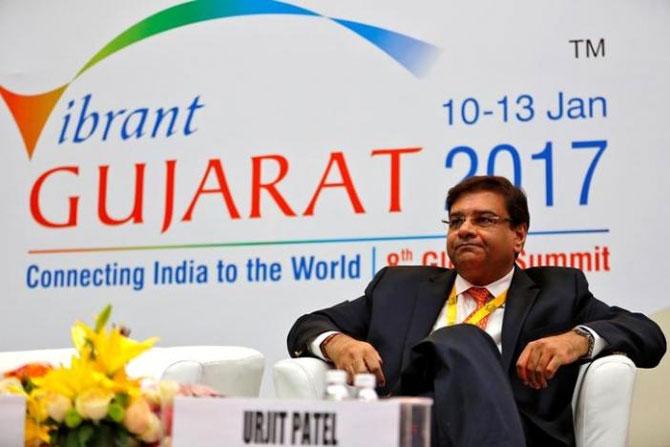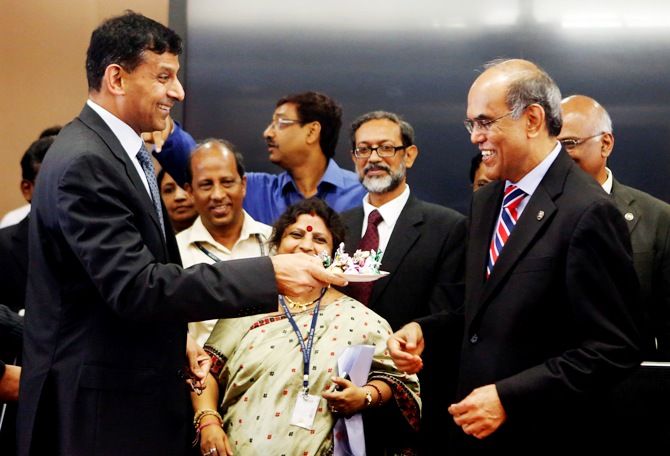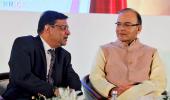The friction with the political class is not only about interest rates and monetary policy.
While the government often spoke freely about its discomfiture, the RBI had to be careful even in its response to the government as any loose statement would affect the markets.
Duvvuri Subbarao's Who Moved My Interest Rate?, notes M S Sriram, is a must read for everyone who wants to understand the relationship between the RBI governor, the central bank and the government.

When Duvvuri Subbarao took charge as governor of the Reserve Bank of India, he faced two challenges: a. The legacy of his predecessor, Dr Yaga Venugopal Reddy, as a forward-looking but conservative and non-compromising governor; and b. The global meltdown triggered by the sub-prime crisis in the US, which had repercussions for the Indian economy.
Dr Subbarao was moving from the finance ministry into the central bank and many thought that he was chosen to toe the ministry line.
The other candidate up for the position -- as we know from Dr Subbarao's book, Who Moved My Interest Rate? -- was Rakesh Mohan, by then a seasoned central banker, having served as a deputy governor.
Dr Subbarao was relatively unknown to the financial world. Few knew what he stood for and if he would stand up to the government the way Dr Reddy did.
Under normal circumstances, Dr Subbarao's tenure would not have warranted much scrutiny. But his five years as governor were one of the most testing stints in recent times, not least because of the sharp global economic slowdown that demanded a finely balanced stewardship of monetary policy and negotiating the tricky path between the political demands of North Block and the imperatives of Mint Road.
On balance, the verdict is that he is one of the best governors the RBI has had. He held a technically appropriate line when there was much scope to buckle under political pressure and heeded to the collective wisdom of the RBI team. That he did so not as a dogma, but chose to constantly communicate the rationale sets him apart.
Unfortunately for Subbarao, assessments of him tend to be diffuse because he was sandwiched between two formidable personalities. His predecessor was Dr Reddy, who had a much larger reputation as a sharp, shrewd and witty governor who was endorsed by no less than Joseph Stiglitz as the best person that the US Federal Reserve did not have, and his successor was Dr Raghuram Rajan whose global reputation as an economist preceded the governorship.
Dr Reddy could take any question with a twinkle in his eye and provide an answer that could, at one level, be diversionary and, at another, be open to multiple interpretations.
Dr Rajan used his opportunity to talk to elevate the discourse to issues much beyond the RBI -- an interesting strategy of continuing communication without really stirring up the markets.
That Dr Rajan stirred up some other hornets's nests is a different matter. Dr Subbarao, in contrast, was not a flamboyant speaker. Even the jokes he made with a deadpan face took time to sink in. But that is not the case with the written word.

Who Moved My Interest Rate? is a remarkable self-assessment and a well-written one at that. It is candid, clear and reveals the vulnerabilities, loneliness, dilemmas and doubts that come with the position of governor.
Dr Subbarao uses the distance of time to assess his tenure with a sense of awe and humility and a wry, self-deprecating sense of humour.
Here is one example: 'So, in one media conference, without any prior contemplation, I found myself likening the Reserve Bank's situation with regard to 'exit' to that of Abhimanyu who knew how to break into the chakravyuh, but ....never got to learn how to break out of it.'
'This wasn't the answer to the question, but the media was nevertheless happy writing stories about whether I would, like Abhimanyu, get trapped in the chakravyuh or, like Arjuna, make a successful exit.'
Though the narrative is personal and introspective, the communication is universal and can be generalised. It needs a skilled writer to elevate personal experiences into insights on a larger framework. Subbarao manages this effortlessly.
This book achieves one of the many things that Dr Subbarao set out to do as governor -- demystify the RBI. He takes us on a tour of the central bank's functions -- monetary policy; inflation-targeting; forex management; banking; the developmental role of financial inclusion; non-bank finance companies -- through the prism of his experiences on Mint Road.
The personal, anecdotal style -- conversations with his wife, the need to step out and take a walk, the awe of the governor's residence and the immediate contrast with the surrounding poverty -- keeps the book firmly grounded and safe from self-aggrandisement.
But this is no anodyne memoir; Dr Subbarao is also candid and does not pull any punches, especially when it comes to expressing his displeasure at the finance ministry, his differences with then finance minister P Chidambaram and the somewhat irrational effects that the strained relationship had on the RBI's functioning.
One episode that resonates is the way the re-appointment of Usha Thorat as a deputy governor was handled, undermining the position of the governor -- somewhat similar to the process that the Modi government followed in finding the successor to Harun Khan who demitted office in 2016.
'Usha became a part of the price we had to pay for asserting the autonomy of the Reserve Bank,' Dr Subbarao writes, and goes on to criticise the process of considering the re-appointment of Subir Gokarn.
These incidents highlight the fact that the friction with the political class is not only about interest rates and monetary policy.
Dr Subbarao takes trouble to explain the position of inflation targeting is not anti-growth and how controlling inflation is a pre-requisite for robust growth.
His differences with both Chidambaram and Pranab Mukherjee (finance ministers during his time) are on how the nuance in the arguments was lost with the government constantly pitting this as a binary issue.
While the government often spoke freely about its discomfiture, the RBI had to be careful even in its response to the government as any loose statement would affect the markets.
As an aside, it is interesting that Chidambaram, who is said to be sensitive to criticism, has provided a fulsome blurb for the book, describing it as 'learned, meticulous and honest'.
The one conspicuous gap in the book is Dr Subbarao's sparing mention of his predecessor. Given that Dr Reddy also had famous run-ins with the government, that he was a much respected governor and belonged to the same cadre (Andhra Pradesh) in their previous avatars as civil servants, one would have expected a much more active exchange of views. But that is not to be found in the book, though Dr Reddy does provide a generous blurb for the jacket.
While there is much warmth for colleagues and even his successor Dr Raghuram Rajan, the silence about Dr Reddy is noteworthy. That certainly does not diminish the value of a wonderful book that takes us through the tumultuous years with insight and a sense of humour.
M S Sriram is visiting faculty with the Centre for Public Policy, Indian Institute of Management-Bangalore.













 © 2025
© 2025